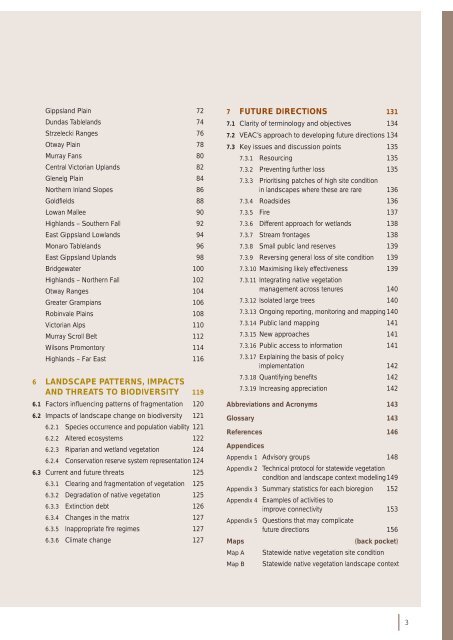Remnant Native Vegetation Investigation Discussion Paper
Remnant Native Vegetation Investigation Discussion Paper
Remnant Native Vegetation Investigation Discussion Paper
You also want an ePaper? Increase the reach of your titles
YUMPU automatically turns print PDFs into web optimized ePapers that Google loves.
Gippsland Plain 72<br />
Dundas Tablelands 74<br />
Strzelecki Ranges 76<br />
Otway Plain 78<br />
Murray Fans 80<br />
Central Victorian Uplands 82<br />
Glenelg Plain 84<br />
Northern Inland Slopes 86<br />
Goldfi elds 88<br />
Lowan Mallee 90<br />
Highlands – Southern Fall 92<br />
East Gippsland Lowlands 94<br />
Monaro Tablelands 96<br />
East Gippsland Uplands 98<br />
Bridgewater 100<br />
Highlands – Northern Fall 102<br />
Otway Ranges 104<br />
Greater Grampians 106<br />
Robinvale Plains 108<br />
Victorian Alps 110<br />
Murray Scroll Belt 112<br />
Wilsons Promontory 114<br />
Highlands – Far East 116<br />
6 LANDSCAPE PATTERNS, IMPACTS<br />
AND THREATS TO BIODIVERSITY 119<br />
6.1 Factors influencing patterns of fragmentation 120<br />
6.2 Impacts of landscape change on biodiversity 121<br />
6.2.1 Species occurrence and population viability 121<br />
6.2.2 Altered ecosystems 122<br />
6.2.3 Riparian and wetland vegetation 124<br />
6.2.4 Conservation reserve system representation 124<br />
6.3 Current and future threats 125<br />
6.3.1 Clearing and fragmentation of vegetation 125<br />
6.3.2 Degradation of native vegetation 125<br />
6.3.3 Extinction debt 126<br />
6.3.4 Changes in the matrix 127<br />
6.3.5 Inappropriate fi re regimes 127<br />
6.3.6 Climate change 127<br />
7 FUTURE DIRECTIONS 131<br />
7.1 Clarity of terminology and objectives 134<br />
7.2 VEAC’s approach to developing future directions 134<br />
7.3 Key issues and discussion points 135<br />
7.3.1 Resourcing 135<br />
7.3.2 Preventing further loss 135<br />
7.3.3 Prioritising patches of high site condition<br />
in landscapes where these are rare 136<br />
7.3.4 Roadsides 136<br />
7.3.5 Fire 137<br />
7.3.6 Different approach for wetlands 138<br />
7.3.7 Stream frontages 138<br />
7.3.8 Small public land reserves 139<br />
7.3.9 Reversing general loss of site condition 139<br />
7.3.10 Maximising likely effectiveness 139<br />
7.3.11 Integrating native vegetation<br />
management across tenures 140<br />
7.3.12 Isolated large trees 140<br />
7.3.13 Ongoing reporting, monitoring and mapping 140<br />
7.3.14 Public land mapping 141<br />
7.3.15 New approaches 141<br />
7.3.16 Public access to information 141<br />
7.3.17 Explaining the basis of policy<br />
implementation 142<br />
7.3.18 Quantifying benefi ts 142<br />
7.3.19 Increasing appreciation 142<br />
Abbreviations and Acronyms 143<br />
Glossary 143<br />
References 146<br />
Appendices<br />
Appendix 1 Advisory groups 148<br />
Appendix 2 Technical protocol for statewide vegetation<br />
condition and landscape context modelling 149<br />
Appendix 3 Summary statistics for each bioregion 152<br />
Appendix 4 Examples of activities to<br />
improve connectivity 153<br />
Appendix 5 Questions that may complicate<br />
future directions 156<br />
Maps<br />
(back pocket)<br />
Map A Statewide native vegetation site condition<br />
Map B Statewide native vegetation landscape context<br />
3
















